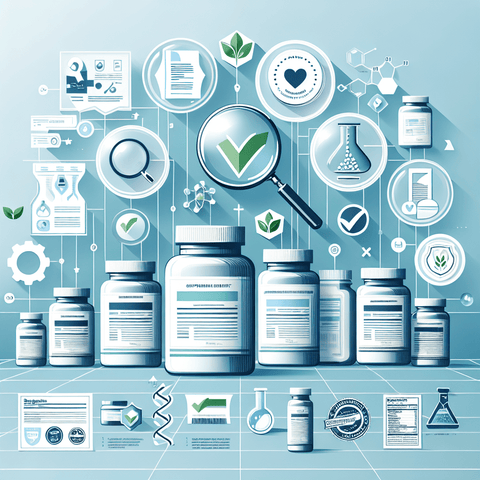Understanding Why Supplement Quality Matters
Choosing nutritional supplements is a common strategy for people aiming to support diet, recovery, or general wellness, but the outcomes depend substantially on product quality. High-quality supplements deliver the promised ingredients at the stated potency and purity, are manufactured under reliable controls, and contain accurate labels so consumers and healthcare providers can use them safely and effectively. Conversely, low-quality supplements can fail to provide active doses, be contaminated with unwanted substances, or carry mislabeled ingredients that create health concerns, unexpected interactions with medications, or simply wasted expense. Understanding why supplement quality matters begins with recognizing the role supplements play: as concentrated sources of vitamins, minerals, amino acids, botanical extracts, or other nutrients intended to complement dietary intake. Because supplements are consumed directly and can contain potent compounds, the safety and integrity of what is inside the bottle directly affects the consumer’s ability to meet health or performance objectives and to avoid harm. In many regulatory jurisdictions supplements are subject to different oversight levels than prescription medicines. This makes purchasing decisions and the choice of trusted brands particularly important. Consumers should therefore evaluate supplements not only on marketing claims or price, but on objective measures of quality such as ingredient sourcing, manufacturing practices, third-party testing, and transparent labeling. A practical approach to evaluating quality includes learning to read supplement facts panels, identifying the source and form of key nutrients, checking for third-party certification seals, and verifying that a manufacturer follows recognized quality standards. Because quality impacts potency, bioavailability, and safety, prioritizing products that demonstrate rigorous quality control reduces the risk of ineffective or unsafe supplementation and increases the probability that nutrient needs will be met. Throughout this guide we will unpack the major criteria that determine supplement quality, explain how to recognize red flags, and provide practical steps to make informed purchases. The goal is to give you usable knowledge to choose supplements that align with reputable manufacturing practices, transparent sourcing, and reliable testing so that your investment in supplements is likely to be both safe and worthwhile.
What Makes a Supplement High-Quality
Defining supplement quality requires looking at multiple interlocking attributes: ingredient identity, potency, purity, bioavailability, label accuracy, and manufacturing consistency. High-quality supplements clearly identify the active ingredient(s), the chemical form used, and the amount per serving, which helps users and clinicians estimate intake relative to dietary needs. Potency refers to whether the product contains the concentration of active constituents claimed on the label throughout its shelf life. Purity means the absence or minimal presence of contaminants such as heavy metals, microbial contaminants, pesticides, solvent residues, or unwanted adulterants. Bioavailability addresses how well the body can access and use the nutrient form provided; for example, certain mineral salts or vitamin derivatives are better absorbed than others, and choice of excipients or delivery systems can influence uptake. Label accuracy is critical: a high-quality product matches its analytical profile to the label declaration, and offers clear instructions for use, storage, and any cautions. Manufacturing consistency means that each batch is produced to the same standard so that consumers receive predictable performance from one bottle to the next. Differences between premium and subpar supplements often show up in sourcing of raw materials, the use of pharmaceutical-grade versus industrial precursors, investment in in-house or contracted laboratory testing, and the rigor of in-process controls that prevent cross-contamination. Premium brands tend to publish certificates of analysis (COAs) or make third-party test reports available, describe the origins and forms of key ingredients, and invest in formulations backed by stability data to support shelf life claims. Subpar products may use proprietary blends that obscure exact ingredient amounts, offer vague sourcing claims, or lack independent verification of purity and potency. By understanding these distinctions, consumers can prioritize products that provide clear, verifiable information and are produced by manufacturers with accountable quality systems rather than relying solely on marketing language or price as proxies for value.
Evaluating Supplement Purity and Safety
Purity is a central pillar of supplement safety and efficacy. Contaminants such as heavy metals (lead, arsenic, cadmium, mercury), pesticide residues, microbial pathogens, unintended pharmaceutical adulterants, and low-quality fillers or diluents can compromise product safety and reduce the effective dose of the target nutrient. Heavy metals may occur when botanical materials are grown in contaminated soil or when manufacturing equipment is not properly controlled. Pesticide residues can remain on extracts if sourcing or extraction processes do not minimize their presence. Microbial contamination can arise from poor sanitation, inadequate drying of botanical raw materials, or inappropriate storage conditions. Additionally, certain low-quality products have been found to include fillers or excipients that dilute active ingredients, and in rare but serious cases some supplements have been intentionally adulterated with pharmaceutical agents to boost perceived efficacy. To assess purity, start with the label and any publicly available testing documents. Look for statements about heavy metal testing, pesticide screening, and microbiological testing. Manufacturers that conduct comprehensive screening will usually note broad testing categories and may provide batch-specific certificates of analysis. When possible, consult third-party lab reports or verification seals from recognized independent testing organizations; these provide stronger assurance than internal testing claims alone. Laboratory testing methods and limits of detection matter, so transparency about what tests were performed and to what standards is useful. Other practical strategies include favoring brands that source raw materials from reputable suppliers, choose ingredient suppliers that provide traceability documentation, and use encapsulation or tablet presses that minimize the risk of cross-contamination. Pay attention to storage and expiration information because degradation products generated during storage can reduce potency or form undesirable compounds. Finally, if a product is marketed for sensitive populations such as pregnant people, infants, older adults, or those with medical conditions, look for additional safety assurances and consult a healthcare professional before use. Prioritizing purity reduces the chance of unexpected exposure to contaminants and increases the likelihood that the supplement will deliver its intended contents safely.
Ingredient Transparency: Know What’s Inside
Clear ingredient transparency empowers consumers to compare products, understand dosing, and avoid unnecessary additives. A high-quality supplement label lists the active ingredient with its specific chemical form and the exact amount per serving. For minerals, forms such as citrate, glycinate, or oxide will have different elemental content and absorption characteristics, so knowing the form is important. For botanical extracts, transparency about extract ratio, standardized marker compounds, and species identification helps evaluate expected activity and consistency. Beware of “proprietary blends” that aggregate multiple components into a single total weight without disclosing individual amounts. Proprietary blends can hide extremely low doses of key actives or concentrate fillers while still carrying bold claims. Instead, prefer transparent formulations where each ingredient is listed with exact quantities and, where relevant, standardization details. Also examine the list of excipients, fillers, flow agents, and capsule materials. Some excipients are benign, while others may be controversial for people with allergies, sensitivities, or dietary restrictions. If you need vegetarian or vegan products, confirm capsule material and ancillary ingredients are free from animal-derived substances. Questions to ask manufacturers include: what is the origin and species identification of botanical raw materials; are active constituents standardized to a defined range; how are raw materials stored and handled to prevent degradation; and what steps are taken to verify identity and potency? Responsible manufacturers will provide answers, or at least documented policies, about sourcing, traceability, and testing. Ingredient transparency also enables healthcare practitioners to assess interactions, overlap with dietary intake, and appropriateness for an individual’s context. When shopping, compare labels side by side and prioritize products that reveal the full composition rather than those that rely on marketing descriptions alone. Clear labels allow informed choices and safer integration of supplements into a broader nutrition and health plan.
Manufacturing Standards and GMP Importance
Manufacturing standards are the operational backbone of supplement quality. Good Manufacturing Practices (GMPs) are a set of principles and procedural controls designed to ensure products are consistently produced and controlled to quality standards appropriate to their intended use. GMPs cover raw material receipt and storage, in-process controls, equipment cleaning and maintenance, personnel training, sanitation, packaging controls, and robust record keeping. In many regions GMP compliance is a legal requirement for manufacturers of dietary supplements, and adherence reduces the risk of contamination, mislabeling, and batch-to-batch variability. However, not all GMP programs are created equal, and consumers benefit from understanding how a brand demonstrates compliance. Some manufacturers operate in facilities that are certified by regulatory authorities or accredited third parties; others may contract manufacturing to facilities that follow pharmaceutical-level practices with stricter controls. Differences in facility design, segregated production lines for allergens, validated cleaning procedures, and environmental monitoring all affect the final product quality. Recognizing brands that adhere to strict manufacturing standards can be done by looking for on-label statements about GMP certification, seeking manufacturer transparency about manufacturing locations, and checking for audits or third-party attestations. High-quality manufacturers often maintain robust quality control laboratories with validated analytical methods to test incoming raw materials and finished products. They also typically document process controls such as weight checks, in-line checks for uniformity, and stability testing to substantiate expiration dates. Manufacturing standards have a direct impact on supplement consistency and safety: well-controlled processes minimize contamination events, maintain potency over shelf life, and ensure that each batch matches the label. When evaluating a brand, consider whether it invests in manufacturing oversight and whether it can demonstrate the measures it takes to maintain consistent, safe production.
Third-Party Testing and Independent Verification
Third-party testing adds an independent layer of assurance that can validate a manufacturer’s internal quality claims. Independent certifying bodies and testing laboratories evaluate supplements for identity, potency, purity, and the presence of contaminants. Common third-party certifiers include organizations that test for label accuracy and contaminants and provide seals or reports that consumers can verify. Third-party testing typically covers assays for active ingredients, heavy metals screening, microbial contaminants, and residual solvents when relevant. Some certifiers also perform functional assays or dissolve tests to assess whether tablets and capsules release their contents appropriately. When a product carries a recognizable third-party seal, look for the seal’s scope and any available batch-specific report. A seal without accessible supporting documentation is less informative than a product for which batch-level certificates of analysis are published online. It is also helpful to recognize what a certifier does not cover; for example, a gluten-free certification focuses on wheat protein contamination and does not automatically ensure freedom from pesticides or heavy metals. Common independent testing organizations include nationally recognized pharmacopeial or quality assurance groups. Consumers should interpret labels and reports with attention to what tests were performed, what standards were applied, and whether the report corresponds to the specific lot they are purchasing. Products that undergo regular third-party testing often highlight that practice as part of their quality messaging. While third-party testing is not a guarantee of absolute safety, it is an important tool for independent verification that decreases the likelihood of undisclosed contaminants and increases confidence that label claims are accurate and reliable.
Quality Assurance Practices for Consistency
Quality assurance (QA) programs are the systematic frameworks manufacturers use to ensure consistent product quality across sourcing, production, and distribution. QA goes beyond spot testing and includes supplier qualification, incoming raw material checks, documented manufacturing procedures, in-process quality controls, and post-market surveillance. A robust QA program often includes supplier audits, raw material identity testing using validated methods, and ongoing stability studies to confirm that products remain within specification throughout their marketed shelf life. Supplier qualification ensures that ingredient sources meet defined standards for identity, purity, and traceability, and that they have appropriate controls to prevent adulteration or variability. In-process controls monitor critical production parameters to prevent errors; for example, weight checks on capsules, visual inspection for tablet defects, and adherence to validated mixing times for uniformity. Post-manufacture QA includes batch release testing, retention sample storage, and mechanisms to trace lots in the event of recalls or adverse events. Transparency about QA practices is a quality signal: brands that publish quality policies, testing methodologies, or that make certificates of analysis available on request demonstrate accountability. Consumer-facing resources, like accessible QA documentation and responsive customer support about lot-specific questions, are helpful when assessing a brand’s commitment to consistent quality. Choosing supplements from companies that prioritize QA reduces the risk of unexpected variability and supports a predictable supplementation experience over time.
Practical Tips For Choosing Supplements
When researching supplement brands and specific products, adopt a checklist approach that balances evidence, transparency, and practical considerations. Start by examining the supplement facts and ingredient list: confirm the active form, the amount per serving, and the presence of any excipients that may be relevant to allergies or preferences. Look for explicit statements about third-party testing, GMP compliance, and whether certificates of analysis for specific lots are available. Contact customer service with targeted questions about sourcing, testing frequency, and manufacturing locations; their responsiveness and the clarity of their answers often reflect the company’s transparency culture. Read independent reviews and expert analyses when available, and interpret consumer reviews carefully — they can reveal packaging or tolerance issues but are less reliable for potency or purity assessments. Keep an eye out for red flags such as exaggerated health claims, proprietary blends without quantities, or lack of batch information. For consumers interested in specific nutrient categories, consider brands that publish category expertise and have curated assortments; for example, product collections for vitamin C, vitamin D, vitamin K, magnesium, or omega-3s can reveal a brand’s depth of formulation and testing in those areas. When evaluating omega-3 supplements, look for information about source species, DHA and EPA concentrations, and purification steps. For minerals like magnesium, review the chemical form and elemental magnesium content. In many cases, paying a moderate premium for products with stronger transparency, third-party testing, and robust manufacturing practices is a cost-effective investment in safety and reliability. Finally, consult a qualified health professional when combining supplements with medications, when treating complex conditions, or when supplementing vulnerable populations to ensure decisions are appropriate and safe.
Conclusion: Prioritize Quality Over Marketing Claims
High-quality supplements are the result of conscientious ingredient sourcing, thorough testing, and disciplined manufacturing and quality assurance systems. Consumers can protect themselves and improve the odds of receiving effective products by focusing on objective indicators of quality: transparent labeling, clear ingredient forms and amounts, documented purity testing, adherence to GMPs, and independent third-party verification where available. Marketing claims and testimonials may be persuasive, but they are not substitutes for verifiable quality assurance practices. Prioritizing brands that publish batch-level testing, provide accessible quality information, and are responsive to consumer questions helps reduce exposure to contamination, mislabeling, and ineffective formulations. Over time, a consistent approach to researching brands, asking specific quality-related questions, and choosing products with traceable sourcing and independent verification will create more reliable supplementation habits. For those exploring specific nutrient categories, brand assortments and curated collections can be helpful starting points; many reputable suppliers maintain targeted ranges for common nutrient concerns and make testing information available. Remember that supplements are intended to complement the diet and that safe integration with medications or medical conditions should be done under professional guidance. By prioritizing quality over marketing, and by using the practical tools outlined earlier in this guide, consumers can make informed choices that align with their priorities for safety, transparency, and consistent product performance.
Appendix: Resources Questions Answers Keywords
This appendix consolidates resources, a focused question and answer section addressing key points from this guide, and a short list of important keywords for future reference. Resources and tools for verifying supplement quality typically include third-party testing organizations, regulatory agencies’ guidance documents, and industry best practice standards. When assessing product pages or brand resources look for certificates of analysis, statements of GMP compliance, and batch-level testing information. For product discovery related to specific nutrients, consult manufacturer collections that focus on those categories to compare formulations and transparency. For example, curated category pages for vitamin C, vitamin D, vitamin K, magnesium, and DHA and EPA omega-3 supplements can help compare ingredient forms and product testing information. If you are shopping online, use the product detail pages to view supplement facts, ingredient source statements, and any available testing documents. Below are concise Q&A items that address common consumer questions, followed by the most important keywords to keep in mind when researching supplements. Q: How do I tell if a supplement has been tested for contaminants? A: Check the product page for statements about heavy metal screening, pesticide and microbial testing, and any accessible certificates of analysis. If not available online, contact customer service and request batch-specific testing documents. Q: Are proprietary blends a red flag? A: Proprietary blends obscure individual ingredient amounts and can make it difficult to know whether key actives are present at meaningful doses. Prefer transparent labels when possible. Q: What role does GMP certification play? A: GMPs are foundational process controls that reduce manufacturing risks; brands that document GMP-compliant facilities or third-party audits generally demonstrate stronger operational quality. Q: How important is third-party testing? A: Third-party testing provides independent verification of label claims and contaminant screening, increasing confidence in product integrity. Q: Should I prioritize price or testing? A: Prioritize verifiable quality and testing over lowest price to reduce risk and obtain consistent results. Important keywords: supplement quality, third-party testing, GMP, certificate of analysis, ingredient transparency, heavy metals, potency, label accuracy, source traceability, batch testing. For curated product categories and to review formulations and testing documentation, explore relevant collections such as the vitamin C collection, the vitamin D collection, the vitamin K collection, the magnesium collection, or the DHA and EPA omega-3 collection on the product site to compare transparency and quality details before purchase.



